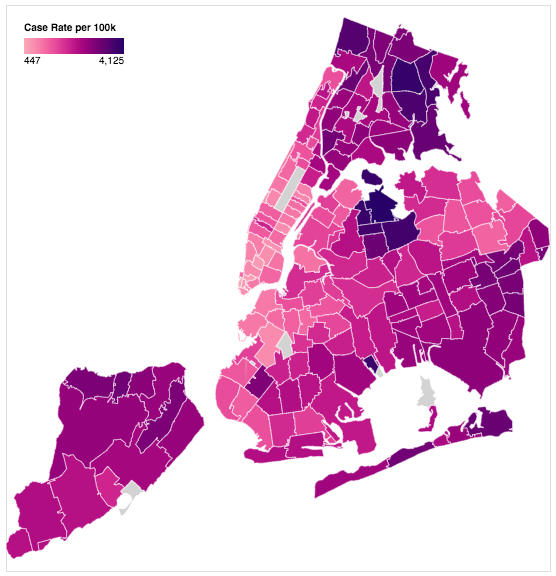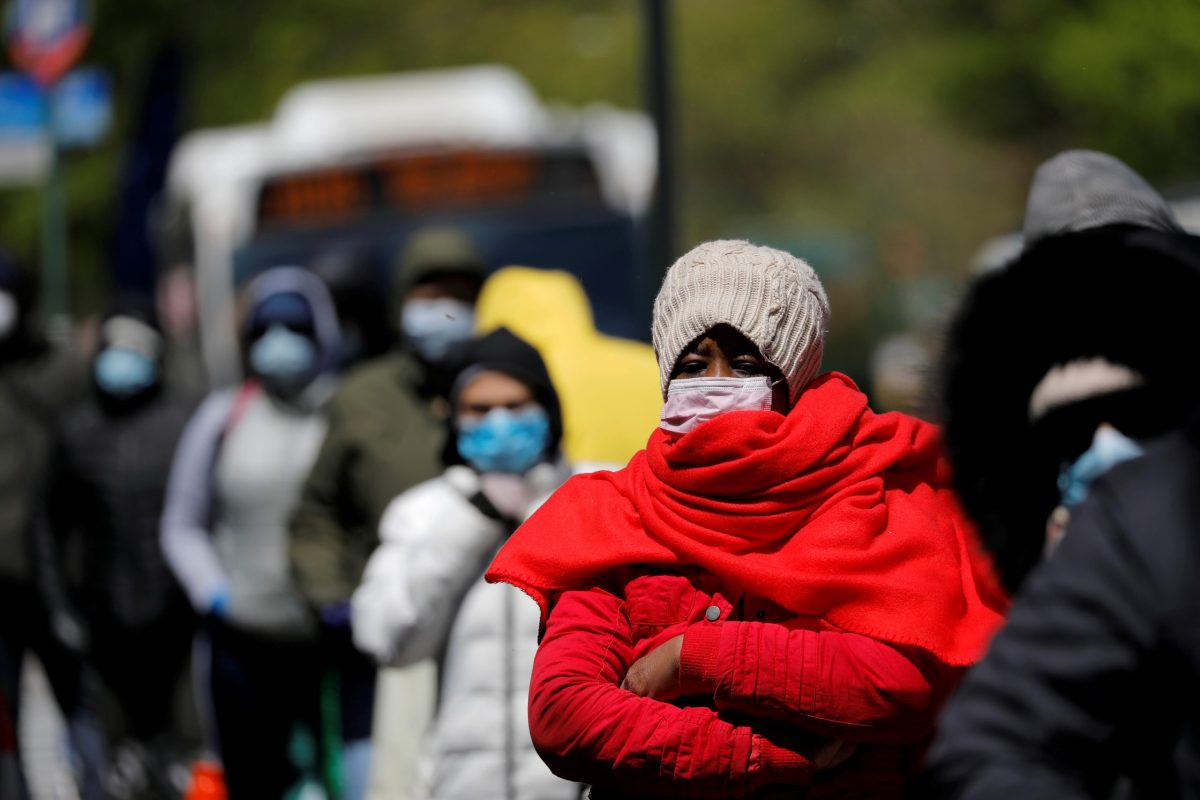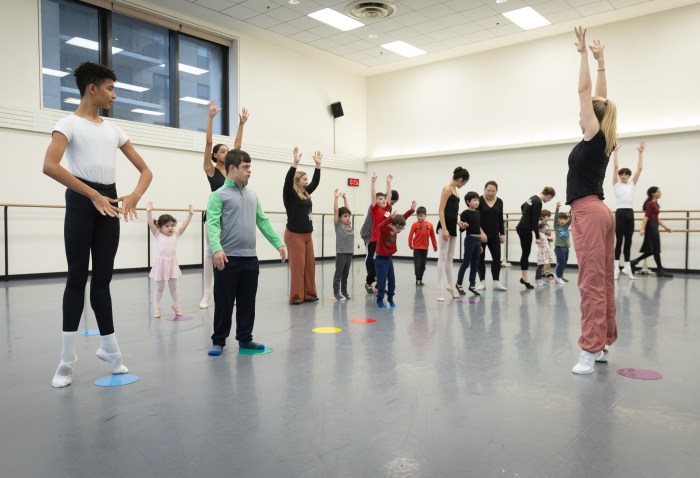From the northernmost tip of Manhattan in Inwood down to East Harlem, communities across Upper Manhattan have suffered the most during the coronavirus outbreak, according to data from the city’s Health Department.
Nine of the top 10 ZIP codes with the most COVID-19 cases are located uptown, generally in communities that are lower-income and include more people of color than communities further south. Northern Manhattan communities had higher rates of cases and deaths per 100,000 people, as well as higher percentages of individuals who tested positive for the virus.
The East Harlem ZIP code of 10029 had the most COVID-19 cases on the island, with 1,698 as of May 18. More than 10% of the patients died, with 182 virus-related deaths reported in the area. The death toll in 10029 was also the highest of any Manhattan ZIP code.
The neighboring ZIP code of 10035, also East Harlem, had the highest case average per 100,000 people, with 2,617.16. There were 901 COVID-19 cases in total there, with 101 resulting in death, or about 11.2% of infected patients.

Central Harlem and Morningside Heights’ 10037 ZIP code had the highest death average per 100,000 people, with 305.09. The area registered 507 total COVID-19 cases, of which 63 resulted in fatalities.
Further north, the Washington Heights-Inwood ZIP code area of 10031 tallied the highest percentage of positive tests for COVID-19, with 36.08%. The community had 1,224 positive cases — the fourth-highest total in Manhattan — and 112 deaths.
The only downtown neighborhood in the top 10 of Manhattan COVID-19 cases was the Union Square-Lower East Side ZIP code of 10002. The area had 975 confirmed COVID-19 cases, of which 138 resulted in death.
| ZIP | Neighborhood | Cases | Cases per 100,000 | Deaths per 100,000 | Percent of people tested who tested positive |
| 10029 | East Harlem | 1698 | 2153.69 | 230.84 | 35.88 |
| 10032 | Washington Heights – Inwood | 1387 | 2255.56 | 237.43 | 35.99 |
| 10033 | Washington Heights – Inwood | 1244 | 2100.98 | 180.71 | 35.46 |
| 10031 | Washington Heights – Inwood | 1224 | 2021.24 | 184.95 | 36.08 |
| 10025 | Upper West Side | 1169 | 1266.06 | 155.96 | 26.28 |
| 10040 | Washington Heights – Inwood | 1055 | 2354.48 | 227.64 | 35.27 |
| 10002 | Union Square – Lower East Side | 975 | 1270.27 | 179.79 | 33.8 |
| 10027 | Central Harlem – Morningside Heights | 959 | 1507.13 | 150.87 | 30.74 |
| 10035 | East Harlem | 901 | 2617.16 | 293.38 | 34.75 |
| 10034 | Washington Heights – Inwood | 667 | 1548.51 | 150.9 | 28.97 |
Meanwhile, further south in Manhattan, the COVID-19 pandemic has not been as devastating.
Nine of the ten Manhattan ZIP codes with the fewest number of COVID-19 cases are located downtown, the majority of which are centered around Lower Manhattan.
The 10006 ZIP code around the Financial District and the World Trade Center had just 23 confirmed COVID-19 cases and zero deaths — the fewest in both categories for the borough.
The nearby Lower Manhattan ZIP code of 10280 in Battery Park City had the third-fewest coronavirus cases with 43, but the lowest case average per 100,000 people, with 447.05.
Tribeca and Lower Manhattan areas within the 10007 ZIP code had the lowest percentage of individuals who tested positive for COVID-19, with 16.18%. The area had 50 cases and three deaths.
The great disparities between north and south in Manhattan reflect the uneven impact of COVID-19 upon the city, which Dr. Oxiris Barbot, the city’s health commissioner, alluded to in announcing the new data on Monday.
For example, more people of color live in the East Harlem ZIP code of 10029, the hardest hit by the COVID-19 pandemic in Manhattan, than in the Downtown ZIP code of 10006, where more than two-thirds of the population is white.
The total population between both areas is starkly different — 3,011 people live in the 10006 ZIP code, and the population density there is 32,796 people per squire mile. The 10029 ZIP code has 76,003 residents and 92,116 people per square mile.
Yet the 10006 ZIP code median income is $119,274, as opposed to the 10029 ZIP code with its median income of just $31,888.
“This public health emergency has affected all of our communities,” said Barbot. “The data also show that this virus is not hitting New Yorkers equitably and that reality is guiding the COVID-19 response.”
In recent weeks, the city has launched a number of programs aimed at closing the health gap in low-income areas and communities of color — including opening additional test sites and expanding mask, glove and PPE distribution.
“It’s really heartbreaking and it should tug at the moral conscience of the city,” said City Councilman Mark Levine, who chairs the City Council’s Health committee, during a Reuters interview. “We knew we had dramatic inequality. This, in graphic form, shows it’s even greater than maybe many of us feared.”
City Councilman Ydanis Rodriguez, who represents northern Manhattan areas hardest hit by the COVID-19 crisis, echoed similar calls Monday for greater action to help black and Latino New Yorkers during the pandemic.
“Black, Latino, and Asian New Yorkers have been impacted the hardest by this virus and it is our responsibility to ensure that they are receiving the support and help they need during these challenging times,” Rodriguez said. He called upon city and state leaders to work with Latino organizations “to help test, trace, and develop a plan to ensure that all New Yorkers regardless of their social or economic standing are protected.”
Find more data about COVID-19 in New York City by visiting www1.nyc.gov/site/doh/covid/covid-19-data.page.




































